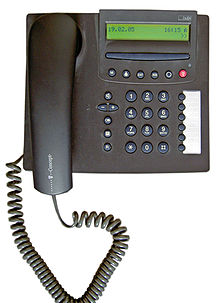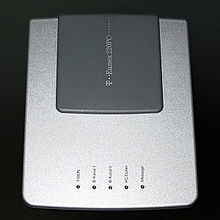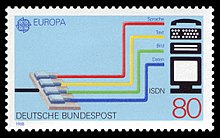Integrated Services Digital Network
![]()
ISDN is a redirect to this article. For the drug substance with the same abbreviation, see isosorbide dinitrate.
Integrated Services Digital Network or Integrated Voice and Data Network (ISDN) is an international standard for a digital telecommunications network. The German-language term Integriertes Sprach- und Datennetz (Integrated Voice and Data Network) was the original term; it stood on an equal footing (sometimes even preferred) alongside the English-language term, which was also introduced in the German-speaking world to reflect the international nature of the system. The international term can alternatively be translated into German as service-integrating digital network. Various services such as telex (telex), teletex, Datex-L (circuit-switched data transmission), Datex-P (packet-switched data transmission) and telephony are transmitted and switched via this network.
Before the introduction of ISDN, there were separate networks for each of these services, between which there were gateways, for example between the telex network and Teletex or from the telephone network to the Datex networks. Since the telephone network was the best-known of the networks mentioned and telephony is still the most frequently used service today, the term ISDN is often equated with telephone.
By replacing analogue exchanges with digital technology, it was possible to double the performance of the subscriber line (two calls or connections simultaneously), while the operation of the terminal equipment remained largely the same for the user. Remote data transmission (e.g. dial-up to the Internet) is faster and more convenient with ISDN than with a telephone modem.
In the meantime, there are other technologies for telephony, such as GSM, UMTS and LTE for mobile telephony, as well as IP telephony (VoIP). For a long time, ISDN formed the basis for all other telephone networks. In terms of network technology, all exchanges in Germany were converted to ISDN, although the subscriber lines did not have to be digitized. The channels of analogue subscribers are converted into a digital signal by the exchanges and passed on. However, new connections in Germany are mostly implemented via Next Generation Network (NGN).
Since the beginning of the 2000s, every member country of the European Union had ISDN telecommunications structures. In Germany, ISDN was available throughout the country.

ISDN telephone
Historical development
Worldwide
In the 1970s, digital technology reached the telephone network and was intended to replace the mechanical exchanges. This was intended to achieve better utilisation of the lines and more convenience for users. The responsible organisation, the Comité Consultatif International Téléphonique et Télégraphique (CCITT, today ITU Telecommunication Standardization Sector (ITU-T), an advisory technical committee of the International Telecommunication Union (ITU)), drew up technical specifications (recommendations) for a digital telephone network for this purpose, which were first adopted under the name ISDN in 1980.
Europe
In the mid-1980s, numerous strategists in the European electrical industry and the then EC Commission feared that Europe would fall far behind the USA and Japan in the field of telecommunications if it did not succeed in abolishing the state monopolistic anachronisms and putting an end to competition between national special solutions.
To prevent this scenario, uniform standards and common markets were to be created. In 1988, the European Commission founded the European Telecommunications Standards Institute (ETSI) to develop standards for a common digital telephone network. On April 6, 1989, under its direction, 26 network operators from 20 European countries launched the DSS1 standard (also called Euro-ISDN), which was intended to unify the national ISDN systems and brought some technical improvements. In December 1993, Euro-ISDN was introduced on the basis of the Memorandum of Understanding on the Implementation of a European ISDN.
Germany
In the Federal Republic of Germany, the Deutsche Bundespost decided in 1979 to digitize all local exchanges. Field tests in Berlin (under the name DIGON = "DIGitales OrtsNetz") had shown that by using digital technology two independent duplex channels could be transmitted simultaneously. In 1982, the decision was made in favor of ISDN technology and the plans were concretized. This was followed by the construction of a test line in West Berlin, and finally two pilot projects in Mannheim and Stuttgart in 1987. In 1989 the official operation of the national ISDN according to the 1TR6 standard began (at that time by the Deutsche Bundespost simply as ISDN, today for better distinguishability called national ISDN). Deutsche Bundespost was thus the pioneer for ISDN in Europe.
The digitisation of the telephone network, which had been analogue for 100 years, was seen as a gigantic investment project with which the Federal Republic and its telecommunications companies were to be catapulted to the top of the promising telecommunications market. From the very beginning, this first major digitization project focused on separating the digital transport path from the services based on it (as an additional communications service). Since the Internet was not yet widespread, the initial thinking was mainly about video transmission or video telephony. Since many consumers did not yet understand the meaning of digitization, the abbreviation "ISDN" was derisively glossed over as the backronym "Is something like that necessary?". At the same time, there were warnings about the risks of ISDN. For example, some data protection experts argued that ISDN was a "qualitative leap" in total data collection, as it enabled the collection and storage of all connection data (cf. data retention).
After the necessary software changes in the exchanges had been completed by May 1994, Euro-ISDN was commercially available in Germany. Since September 1995, the telephone network has been digitized to such an extent that ISDN is available nationwide (in the case of exchanges which are not yet digital, by means of third-party connection; complete digitization was achieved at the end of 1997). Until mid-1996, the conversion to ISDN technology was supported by Deutsche Telekom with a large subsidy - up to DM 300 was credited for a new connection and up to DM 700 for the purchase of a telephone system.
For a long time, the marketing of ISDN was of extraordinary strategic importance in Deutsche Telekom's business strategy. For this reason, Deutsche Telekom was the only established network operator in the world to opt for ADSL-over-ISDN (Annex B), which has disadvantages in terms of range and bandwidth, when introducing ADSL technology throughout the country. Customers with analog T-Net connections should not have any DSL availability or bandwidth advantages over T-ISDN customers. With the migration to NGN, Deutsche Telekom will no longer market ISDN, and ISDN lines have been terminated by providers in order to test the migration to IP-based lines in the country. Deutsche Telekom will use Annex J for IP-based connections for splitterless DSL ("DSL without splitters"). According to planning, this means the end for ISDN telephone connections (and thus for ADSL-over-ISDN, "Annex B") in Deutsche Telekom's network.
At the end of 2006, there were 12.65 million basic ISDN lines (exactly one third of all telephone lines) and 113,000 ISDN primary multiplex lines. In 2016, there were 8.23 million analogue, 4.57 million basic and 85,000 primary multiplex connections as well as 26,000 public telephone stations, and the trend is still downward.
In 2009, 32.1 % of all households in the Federal Republic had ISDN connections. From 2007 to 2013, the number of basic ISDN connections in Germany fell from 12.86 million to 9.02 million.
Telekom originally announced that it would have completed the migration of all customers with ISDN lines to other products by 2018. This date has been postponed several times, most recently to the end of 2020. There is currently (as of March 2021) no evidence that Telekom has now switched off ISDN. Other providers (e.g. Vodafone) advertise that they want to enable a "soft migration" for their existing ISDN customers by 2022.
Austria
In Austria, digitization began in 1978 with the introduction of the OES (Oesterreichisches Elektronisches System) by the Postal and Telegraph Administration (PTV). From 1986 onwards, OES technology was used nationwide. In February 1992, an ISDN pilot trial was started in the area of the Vienna local exchange "Dreihufeisengasse", to which 200 basic access lines had already been connected by the end of the year. By 1999, the entire Austrian telephone network had been digitized, and in that year there were a total of 247,000 ISDN connections. In 2002, the number rose to a total of 438,000. The Austrian implementation of ISDN differs from others, among other things, in that there is a "global number" that cannot be assigned to any device by MSN. Some ISDN devices (e.g. telephone systems) have to take this specific feature into account in order to function without problems. With Telekom Austria's product AON-Complete - the first Austrian Internet flat rate - there was a boom in new ISDN registrations on November 15, 1999. While one ISDN B-channel served the Internet flat rate, telephony was possible via the second B-channel at the same time. Due to massive protests by competitors, the ISDN Complete rate was discontinued for new customers at the end of February 2000.
Switzerland
In Switzerland, the first ISDN was put into operation in 1988 with Swissnet 1. By 1996, a total of 250,000 customers had been acquired, and in 2004 there were over 900,000 connections. In 2008, however, the proportion of ISDN connections shrank again. Since at that time a VDSL modem reaches data transmission rates of 20,000 kbit/s in the direction of reception via an analogue line, the importance of ISDN and the limitation of ADSL-over-ISDN has diminished. In addition, the provider Swisscom (which is the only one to offer ISDN in the opening market) is countered by other solutions: Sunrise Communications as well as Salt Mobile with pure wireless solutions, as well as various cable network operators (such as UPC Switzerland, Quickline, NetPlus, ImporWare - in total well over 1 million customers) with an offer for data, telephone, fax and TV signal for over 200 channels, including much in HDTV quality on broadband networks. Swisscom launched its large-scale switch from ISDN to IP in 2017. All connections were converted by the end of September 2019.
USA
In the USA, the 5ESS system was introduced in 1992 under the name NI-1 (US National ISDN Phase 1), which was very different from DSS1. Later, an improved version of this system was introduced as NI-2. Due to the lack of promotion and the pricing, this system has remained only a niche product in the USA.
In parallel, AT&T offers its own end-user only NI-1 compatible system under the name "5ESS". The 5ESS-2000 data standard, based on Very Compact Digital Exchange (VCDX), provides NI-1 features for digital terminals at an analog exchange and is thus a bridging technology between analog and digital telephony for a relatively small customer base.
International distribution
The spread of ISDN developed very differently around the world.
| ISDN lines per 1000 inhabitants in 2005: | |
| Norway | 401 |
| Denmark | 339 |
| Germany | 333 |
| Switzerland | 331 |
| Japan | 240 |
| United Kingdom | 170 |
| Finland | 170 |
| Sweden | 140 |
| Italy | 105 |
| France | 90 |
| Spain | 58 |
| USA | 47 |

ISDN telephone system Eumex 220PC

ISDN: Special stamp of the German Federal Post Office from 1988
Differences to the analogue connection
The main difference to the analogue fixed network connection is the digital transmission up to the end device. This makes it possible to transmit several channels simultaneously via one connection. With the basic ISDN connection, two channels are available that can be used completely independently of each other for telephone calls, fax or data transmissions; for example, you can send a fax during a telephone call or make a telephone call and surf the Internet (without ADSL) at the same time.
For an ISDN multi-device connection, up to 10 telephone numbers (called Multiple Subscriber Numbers, MSN) can be assigned in Germany, which can be distributed to the ISDN terminals as desired. Distinguished by the service identifiers, one MSN can be used for different applications (services), for example for telephony and ISDN data transmission, without them interfering with each other - in theory. In practice, conflicts occur when, for example, a fax from an analogue connection (i.e. without a service code) calls an MSN which only distinguishes between fax and telephone by means of a service code. In practice, therefore, one usually did not rely on this function, but assigned one of the ten MSNs for each device. In addition, ISDN provides numerous switching features whose control information - as well as the signalling for establishing and terminating connections - is transmitted via a separate data channel (D channel).
Digital transmission enables numerous quality improvements compared to analogue technology: The signals can be transmitted loss-free with continuous digital transmission. With analog transmission, the signal is only amplified, not regenerated. In the process, not only the useful signal is amplified, but also noise and extraneous voltages. The longer the connection distance, the lower the signal-to-noise ratio in analogue transmission, and thus the quality of the transmission deteriorates. The voice quality of digital transmissions is therefore significantly better. In addition, data transmissions are faster, since no modem has to be interposed, but the data is transmitted directly via the network. In principle, transmission over an access line can be much faster than the ISDN speed of 2 × 64 kbit/s (for example, with DSL) if effective coding and modulation methods are used, but the limitation to the frequency range of 300 Hz to 3400 Hz typical for voice in the transmission and switching systems restricts the speed.
To connect analogue terminals such as telephone, fax, answering machine or modem to an ISDN line, you need an a/b converter, also known as a terminal adapter (abbreviated TA), or an ISDN telephone system with analogue extension lines.
The disadvantage of ISDN technology compared to analogue connections is that operation of a simple corded telephone without an independent power supply is not provided for in regular operation - at least either NTBA or the ISDN telephone must be supplied with power externally in regular operation according to the ISDN specification. The exception to this is emergency operation, in which, if the NTBA is not supplied with mains voltage, the supply voltage on the S0 bus is reversed, thereby signalling to the (then only permissible) terminal device that it must limit its consumption.
Search within the encyclopedia